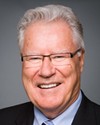Mr. Speaker, it is my pleasure to speak to the House about Bill S-8, the safe drinking water for first nations act, a piece of legislation that deserves the full support of this House.
The proposed legislation is a crucial component of an integrated plan to resolve an issue that has persisted for far too many years and that threatens the health of tens of thousands of Canadians. Until regulations and standards are in place, the safety and quality of the water in first nations communities will remain at risk, posing a significant health risk.
I call on the opposition to stop stalling and to vote in support of this important legislation.
The long-term plan to improve the quality of drinking water in first nations communities is based on three pillars: capacity-building and operator training; investments in water and waste water infrastructure; and enforceable standards and protocols, which would be this legislation. Each of these pillars is designed to contribute in a specific way to the larger goal, which is access to safe drinking water for all first nations communities.
Improving operator training and community capacity is a case in point. One of the key problems identified in several studies on drinking water in first nations communities was the lack of capacity to operate and maintain water and waste water treatment facilities. In many case, there are simply not enough trained operators available to keep facilities running properly. Without trained and certified operators, any water system, regardless of where it is located, is unlikely to produce safe drinking water over the long term. The challenge is even greater when the system is in a remote part of the country, as so many first nations communities are. It is notoriously difficult to attract qualified workers and to retain them in these remote communities. This is true for a wide range of occupations. The remoteness of a community also contributes to delays in obtaining supplies, replacement parts and qualified repair technicians, which in turn can cause the system components to wear out more quickly.
The best way to address these challenges is to train and employ community residents, because they have a personal stake in ensuring the availability of safe, clean and reliable drinking water in their own communities. This is precisely what the circuit rider training program does.
Under this highly successful program, trainers travel to first nations communities and provide system operators with on-site, hands-on training on how to operate, maintain and monitor water and waste water systems. To increase the number of trained and certified operators, our government invests approximately $10 million each year in this program. Thanks to the circuit rider training program, there are now more trained and certified system operators than ever before.
In 2011, the national assessment determined that operators with the appropriate level of certification managed only 51% of first nations' water systems and 42% of first nations' waste water systems. One year later, annual performance inspections of the same systems concluded that these numbers had increased to 60% and 54% respectively.
Obviously, systems operated by properly trained and certified staff are more likely to consistently produce safe drinking water.
Less obvious, perhaps, are two other important benefits. First, properly trained operators are better able to ensure that facilities function effectively throughout their expected service life, maximizing the value of the infrastructure investments. Another benefit is that trained and certified operators will be better able to ensure that their systems can meet future regulatory standards.
Even the best qualified operators would struggle to consistently produce safe drinking water if they had to work with outdated or unserviceable equipment. That is why investments in water system infrastructure represent the second pillar in the Government of Canada's strategy to improve the quality of drinking water in first nations communities. Between 2006 and 2014, our government will have invested approximately $3 billion in water and waste water infrastructure in first nations communities. Economic action plan 2012 included more than $330 million over two years to build and renovate water and waste water infrastructure.
In this 2012-13 fiscal year alone, this investment supported some 286 major water and waste water infrastructure projects in first nation communities across the country. The government would continue to provide funding so that first nations could improve the quality of their water system infrastructure.
To get the full value of infrastructure investments, however, water systems must also be supported by enforceable regulations. That is what we are talking about today. These regulations would specify treatment standards, testing protocols, allowable levels of contaminants and all of the other factors that help define safe drinking water.
Regulations would foster accountability and provide community residents with the assurance they need to trust the water that comes out of their tap. Delivering safe drinking water on a consistent basis would require a chain of interventions: sources must be protected, for instance; and water must be filtered, treated and tested. Although these processes may vary, based upon the quality of the source water and the size of the distribution network, they must all be solid. Also, like all chains, the one that safeguards drinking water is only as strong as its weakest link.
Regulations would represent a key component of the overall process. They would specify science-based standards for quality testing, treatment protocols and other factors. Regulations would also assign responsibility for specific tasks. The organizations, such as municipal utilities, that supply water to the public must abide by these regulations.
Without regulations, there could be no assurance of the safety of drinking water in first nation communities. Regulations would provide the overarching framework of a drinking water system and guide the efforts of everyone involved in the system.
Bill S-8 would include a mechanism to establish regulatory regimes concerning the drinking water systems in first nation communities. This it the third pillar of the plan. The regimes would include rigorous standards and protocols and promote the accountability necessary to ensure that first nation communities have access to safe, clean and reliable drinking water.
To develop regulations, the legislation calls for a collaborative, region-by-region approach. In each region, first nations, the Government of Canada and other stakeholder groups would, together, design a regulatory regime tailored to local circumstances. The regulations used in nearby communities, such as provincial regimes, would serve as valuable guidelines.
I believe there is a tremendous value in this approach, because existing regulations are typically informed by the real-world challenges of producing water in a particular part of the country—challenges such as geography, weather and the quality and availability of water sources.
All three pillars must be in place to ensure that residents of first nation communities can access safe drinking water on a consistent and reliable basis. Operators must be properly trained; facilities must be functional; and standards, guidelines and protocols must be backed by regulations that must be in place.
Considerable progress has been made on all of these during the past seven years. The legislation now before us would support further progress.
Bill S-8 would be an essential part of a sensible, practical and balanced plan to improve the quality of drinking water and protect the long-term health of tens of thousands of Canadians.
Currently, laws are in place to protect the safety of drinking water accessed by every other Canadian, except for those living on reserve.
I call upon the opposition to stand up for first nations across this country and support Bill S-8.









